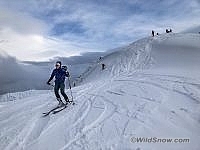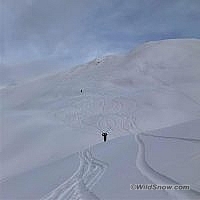This post sponsored by our publishing partner Cripple Creek Backcountry.
I’m sitting down to write this on Tuesday December 4th; my office just rattled — a 3.1 magnitude aftershock.
At 8:29 am last Friday, I found myself at what T.S. Eliot might call a “still point of the turning world.” The ground beneath my feet began to shake, violently. The dog barked, lights went dark, the world spun, books and pictures fell to the ground, and a low droning sound rumbled through the air. In that moment the world shrank to the immediate. I ran to the doorway, then wondered why I didn’t just keep going, so I went outside.
Standing in the snow and dark in my slippers as the earthquake subsided, I heard sirens in the distance and the hoot of an owl in a nearby tree; “at the still point, there the dance is…” The ground regained its stability, but the stillness in my mind evaporated with worries about my wife, our house, our city, and friends.
Anchorage experienced a 7.0 earthquake caused by the tectonic plate under the Pacific Ocean diving underneath Alaska. These tectonics are responsible for the Chugach Mountains that I love so much. Roads collapsed, drywall cracked, and engineers got to work, but not a single person died and there were few injuries even as bad as broken bones across the biggest population center in the state.
Immediately after the earthquake, power (and internet) was down at my house, I couldn’t get a cell phone call out because the towers were jammed, and all the radio stations had been knocked off the air. This was an eerie and somewhat terrifying calm broken six minutes later by a text message from my wife saying that she was fine (though a shelf of CDs had fallen on her in the 4th-floor doorway at the radio station downtown).
You often hear that it’s good to shake things up every now and again, but rarely hear about cleaning up the mess. My skis fell off a rack in the garage. I didn’t put them back up, fearing one of the hundreds of aftershocks that have continued since the quake might knock them back down. I looked for damage around the house, and consoled my terrified dog Ziggy. It didn’t take long for me to want to escape the stress of disaster management and head for the hills.
Luckily by Friday evening things already returned to some sense of normalcy. I don’t mean to minimize the real damage, rather I am incredibly impressed with the response and resilience Anchorage has shown. I drove into town at 6 pm and crews were already out repairing damaged roads.
Two aftershocks greater than 5.0 and countless small shakes made for a restless night. The next morning I drove down the hill from our house in the dark and piled in to a friend’s car heading south in search of solace on our skis. Some might see this as a selfish choice, but I don’t know how to rebuild highway onramps or fix broken water mains. Just putting skis in the car did wonders to fix our mental, if not literal, instability.
After woots of ‘Powtober’ were heard earlier this fall, AK has had an unusually warm early winter. December should mean touring is easy to find, but unfortunately, rain, warm air, and wind have meant that the ski season is off to a slow and rocky start. We drove past Girdwood in a downpour.
Eric said, “I know this is a pretty ‘gung-ho’ group, but I think this might be a one-run day, eh?”
“Or is it a no-run day?” I responded, looking down at my soft-shell pants.
Perseverance lead to a ‘sucker hole hanging out in the middle of Turnagain Pass. We pulled over in the Tincan parking lot. One other car was already there, gearing up in the 10AM late morning dawn. This time of year in AK it seems like you tend to know whoever you run into. Our group grew and we headed out.
I found myself humming ‘November Rain’ all too often last month and out of a post-quake stubbornness I refused to start off December in sneakers. So, we skinned from the car over grass, ice, and alders hopeful that snowline was just around the corner. It was not. Booting up the grassy hillside that most years is the most popular ski touring destination in Alaska, we saw some small slides up high on nearby peaks and wondered which ones were shaken loose the day before.
We hit consistent snow (or rain crust I should say) another few hundred vertical feet up and slowly started feeling a bit better. The skin track was the perfect opportunity to share stories from the day before. One friend pulled over while driving, thinking their car was breaking down; another casually sat at a coffee shop watching others duck and cover. When the window next to her shattered, she finally decided it was worth moving.
All the while the snow slowly improved — supportable crust, hot pow, to finally full on light fluffy powder snow. Tracks from earlier in the week had filled in, and we headed up Tincan Common.
The upper run is only about 600 vertical feet, but we couldn’t complain about a perfect open alpine bowl. Two miles and 2300 vertical feet from the car we crested the ridge and the sun broke through the clouds.
We had the place to ourselves and forgot about the earthquake. Hooting and hollering in the pow, we wiggled our way down.
“Hey, Tom and Alex!”
Heading into our second lap, we heard our names shouted from a group below. Our group grew again. By the time we made it up for our third lap, there were 18 people and two dogs. Stoke grew with the crowd.
On lap four, Eric stomped a backflip, which coaxed two friends who had said they were done for the day to turn around and get one more run in. On lap five, we finally had to cross old tracks and figured the day was done. Skiing out with what had become a group of seven friends, we passed two more parties heading up. This seemed odd since it gets dark now before 4 pm, but I couldn’t blame them, sliding on snow sure made us feel like the world wasn’t crumbling.
The sucker hole closed just as we got back to the car. At least the rain down low was probably snow up high. Some 25 people headed to Tincan that day. A small number, considering it was a Saturday and the first day of December, but a big number considering the highway had been closed due to a landslide the day before. I usually don’t like heading to the crowded spots at Turnagain, preferring the quiet and solitude of neighboring mountains. Saturday, I thought the community out at Tincan was a welcomed sight to see.
When I got home I remembered the earthquake; aftershocks woke me up again Saturday night, so I went skiing again on Sunday.
Dr. Alex Lee lives in Anchorage, Alaska. Alex is a professor at Alaska Pacific University, teaching philosophy and environmental studies. He also works as a sometimes guide, naturalist, writer, and photographer.


